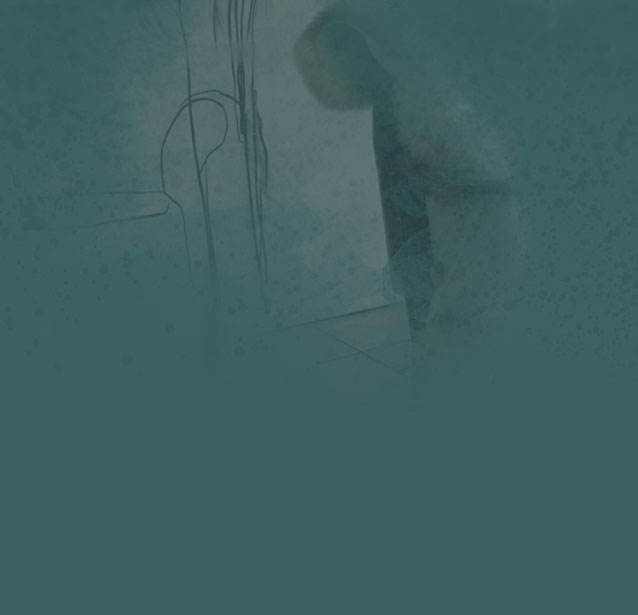Home
Seegård Church
The architect for Seegård Church was Arne Thorsrud. Håkon Gullvåg’s decoration for Seegård consists of a monumental altarpiece. Christ almost hovers out from a colossal wooden panel, with his scarred hands stretched towards us, but then the scene dissolves into divine and blinding light. The painted light is underscored by the architectural design: The apsidal wall is slanted but the altarpiece stands perpendicular. As such, its panel cuts into the wall and creates a small apse. Daylight floods down from a light shaft above, and this device renders an almost celestial light; the natural mutations of daylight instigate a beautiful play of colours in the altarpiece, such that it shimmers in a distinctly different light than what is experienced in the rest of the church.
In the rectangular field under the Christ-figure, the artist has drawn a “checkerboard” with pictorial spaces. This can be reminiscent of a predella: the long and narrow base under an altarpiece’s middle panel, usually decorated with scenes in narrative progression. In the Seegård altar, we follow the events of Jesus’ last days (The Passion of Christ), with the Triumphal Entry into Jerusalem and the Last Supper on the left. To the right is the Ascent to Golgotha, the Crucifixion and the Deposition. It is particularly during the Lord’s Supper, when parishioners congregate around the altar, that these pictures are seen to best advantage.
As we kneel to celebrate the Eucharist, we can dwell on the stories of the suffering Son of God, but then we lift our eyes to celebrate that he has risen from the dead in triumph. Gullvåg’s version of the Resurrection is a prime example of a picture’s capacity for telling several stories simultaneously; for example, the risen Christ is flanked by tiny symbols of the four evangelists, which allude to Judgment day. The way the Christ figure dissolves in light can also draw associations to his ascension, and we take part in the moment when Jesus no longer is of this world, but is taken up into the divine realm.
In our meeting the altarpiece, we are not satisfied merely with an explication of the theological content, but we experience a mood, a sense of something unsayable and mystical that is just as important. The polyvalence of the work gives us the possibility of completing it with our own personal associations and visions.
The architect for Seegård Church was Arne Thorsrud. Håkon Gullvåg’s decoration for Seegård consists of a monumental altarpiece. Christ almost hovers out from a colossal wooden panel, with his scarred hands stretched towards us, but then the scene dissolves into divine and blinding light. The painted light is underscored by the architectural design: The apsidal wall is slanted but the altarpiece stands perpendicular. As such, its panel cuts into the wall and creates a small apse. Daylight floods down from a light shaft above, and this device renders an almost celestial light; the natural mutations of daylight instigate a beautiful play of colours in the altarpiece, such that it shimmers in a distinctly different light than what is experienced in the rest of the church.
In the rectangular field under the Christ-figure, the artist has drawn a “checkerboard” with pictorial spaces. This can be reminiscent of a predella: the long and narrow base under an altarpiece’s middle panel, usually decorated with scenes in narrative progression. In the Seegård altar, we follow the events of Jesus’ last days (The Passion of Christ), with the Triumphal Entry into Jerusalem and the Last Supper on the left. To the right is the Ascent to Golgotha, the Crucifixion and the Deposition. It is particularly during the Lord’s Supper, when parishioners congregate around the altar, that these pictures are seen to best advantage.
As we kneel to celebrate the Eucharist, we can dwell on the stories of the suffering Son of God, but then we lift our eyes to celebrate that he has risen from the dead in triumph. Gullvåg’s version of the Resurrection is a prime example of a picture’s capacity for telling several stories simultaneously; for example, the risen Christ is flanked by tiny symbols of the four evangelists, which allude to Judgment day. The way the Christ figure dissolves in light can also draw associations to his ascension, and we take part in the moment when Jesus no longer is of this world, but is taken up into the divine realm.
In our meeting the altarpiece, we are not satisfied merely with an explication of the theological content, but we experience a mood, a sense of something unsayable and mystical that is just as important. The polyvalence of the work gives us the possibility of completing it with our own personal associations and visions.
HÅKON GULLVÅG © / TEXTS BY DANIEL JOHANSEN AND EVA FURSETH / SITE BY KLIPP OG LIM































































